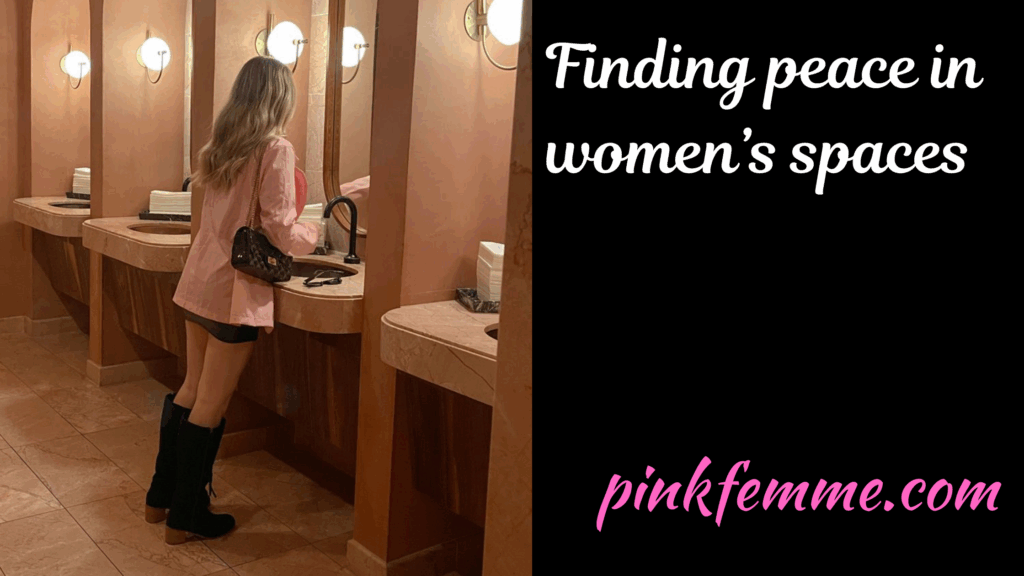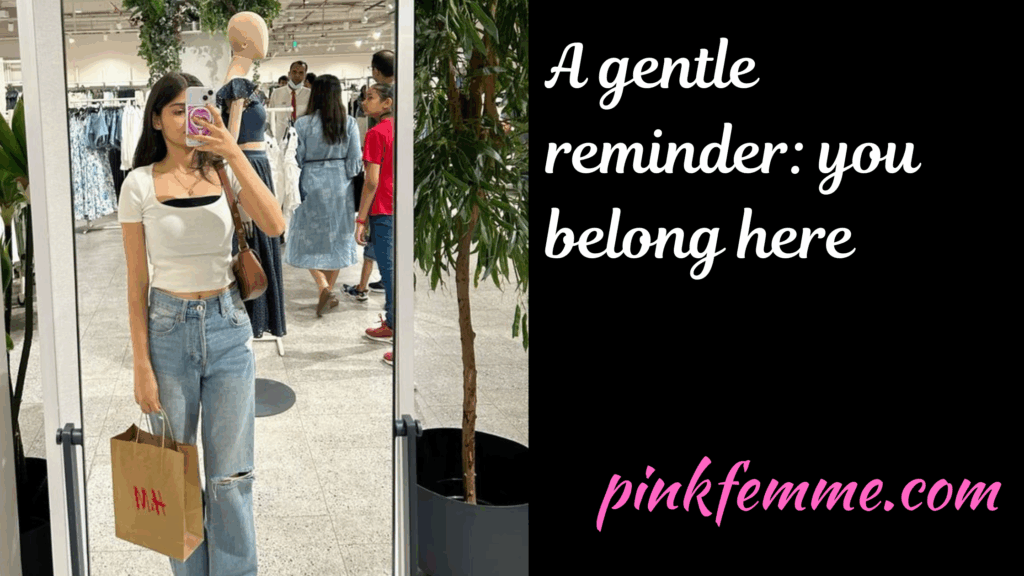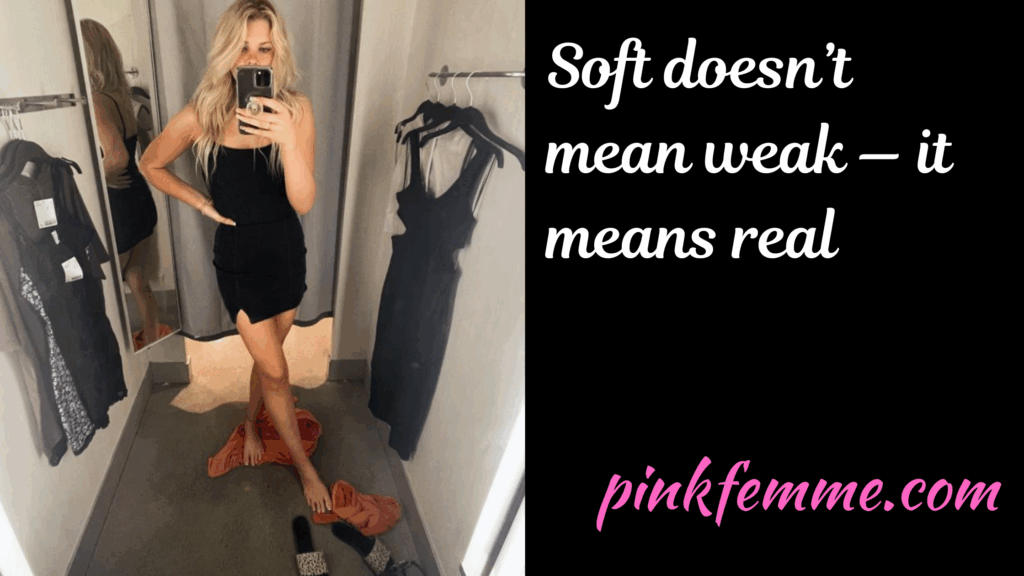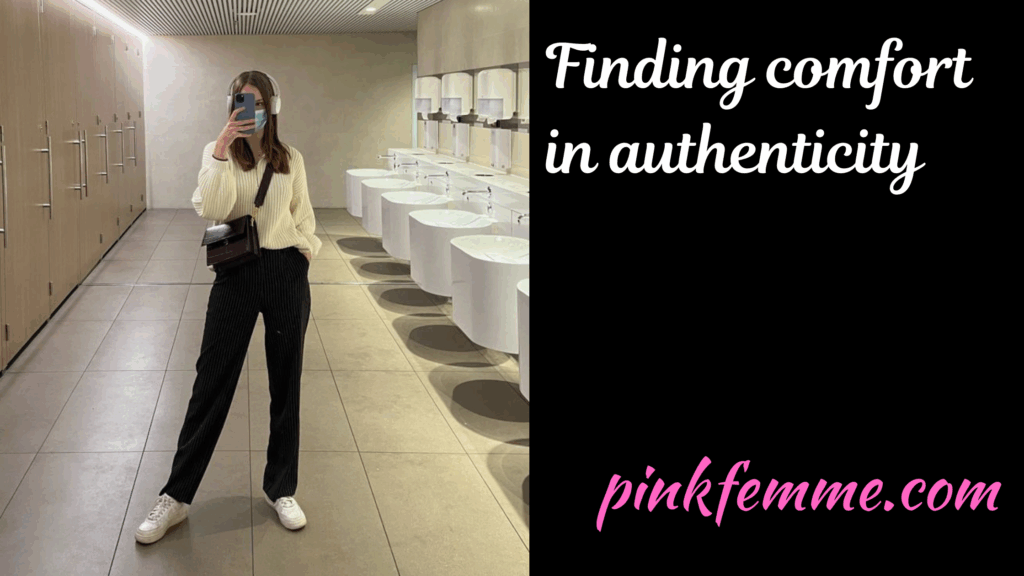
If you’ve ever felt your heart race or your breath catch when stepping into a women’s space — like a locker room, spa, or public bathroom — you’re not alone. As a transgender woman, I know how those moments can stir up deep layers of emotion, anxiety, and dysphoria. I’ve been there — caught between wanting to simply be and the inner voice that whispers, Do I belong here? This article comes from that place of empathy and shared experience — and I want to walk beside you through it.
Gender dysphoria can increase in women-specific spaces due to internalized fear, self-criticism, or imposter feelings. Understanding why this happens helps trans women reduce anxiety and navigate these spaces with greater confidence and self-compassion.
Even if you’ve worked hard to affirm your identity and live authentically, certain environments can still trigger old fears or new insecurities. Let’s explore why that happens and how you can move through those moments with strength, grace, and self-acceptance.
When Anxiety Rises in Women’s Spaces
For many of us, being in women-centric spaces — bathrooms, changing rooms, spas, or gyms — can feel both affirming and intimidating. These are places that often carry quiet rituals of femininity: women adjusting their hair in the mirror, chatting softly as they change, or moving with ease in a shared sense of belonging. For a trans woman, these spaces can feel like both a dream realized and a challenge to navigate — a moment of affirmation met with an undercurrent of vulnerability.
It’s not just about the physical space itself; it’s about what that space represents. Women’s spaces have long been shaped by deep social scripts — unspoken expectations of what “womanhood” looks and sounds like. When you step into that world, especially as a trans woman, it can awaken layers of awareness that most others may never even think about. Suddenly, a simple act like washing your hands or fixing your lipstick can feel like an emotional tightrope walk between visibility and safety, between belonging and fear of judgment.
That heightened awareness can be exhausting. You might notice yourself paying attention to everything — your posture, your voice, how long you stay at the mirror, even where your eyes rest. It’s as if your mind is running quiet background checks on yourself: Am I blending in? Do I seem natural? Does anyone notice me? This internal dialogue, though often invisible to others, can be incredibly draining because it’s fueled by years of conditioning and lived experience — moments of misunderstanding, of scrutiny, or of feeling othered.
Sometimes, that anxiety isn’t even about the present moment; it’s a reflection of the past. It may echo early experiences of being excluded, questioned, or made to feel out of place. Those emotional imprints can resurface in even the most benign settings, especially when your surroundings are so symbolically tied to womanhood and belonging.
And yet, there’s also beauty in these spaces — a quiet reminder of why we longed to be part of them in the first place. The laughter between friends, the scent of lotion and perfume, the soft hum of hairdryers or whispered conversations — all these sensory details can feel like small affirmations of your identity. You’re not an outsider peering in; you’re part of the rhythm of it all.
It’s completely natural, though, that such moments might stir a complex mix of emotions — pride, joy, fear, even grief. You can hold all of that at once. There’s no “right” way to feel here. What matters most is recognizing that the tension you feel isn’t a flaw in you; it’s a reflection of the world you’ve had to navigate and the strength it takes to keep showing up as yourself.
Over the years, I’ve noticed two common patterns in how this kind of anxiety tends to appear. Understanding which one resonates with you can be a gentle, powerful first step toward easing that inner tension and reclaiming peace in these spaces that rightfully belong to you.
1. The Midpoint of Transition: When Confidence Feels Fragile
If you’re still navigating your transition, it’s completely normal to feel uncertain in these spaces. That sense of vulnerability doesn’t mean you’re doing anything wrong — it means you’re human, and you’re in the process of growing into yourself. These moments often arrive quietly, in places where you’d like to feel at ease but instead feel hyper-aware — the sound of your heels clicking too loudly, a glance in the mirror that makes you question every detail, or the quick flicker of another woman’s gaze that you can’t quite interpret.
The midpoint of transition can feel like standing on a bridge — you’ve come so far from where you started, but you’re not yet fully where you want to be. It’s a tender, transformative space. Your identity feels stronger than ever, yet your confidence may still waver. And that’s okay. The in-between can be uncomfortable because it’s full of movement and change. Your body, your presentation, even the way you’re seen by the world — everything is shifting, and that can leave you feeling both exposed and uncertain.

At this stage, many of us hold ourselves to impossibly high standards. We want to be effortlessly confident, graceful, and accepted. We imagine that other women never second-guess themselves, when in truth, most women — cis or trans — carry insecurities of their own. But when you’re in transition, that self-critical lens can feel magnified. Every perceived imperfection can seem like proof that you’re somehow “not enough.”
You might find yourself scanning for signs of rejection before they even happen. Are they looking at me? Do they notice something? What if I don’t belong here? These thoughts are powerful not because they’re true, but because they touch on something deeply emotional — the desire to be seen as your authentic self, without question.
The mind loves to fill uncertainty with stories, and often those stories are fueled by fear. Catastrophizing becomes a kind of emotional reflex: imagining that one look, one comment, or one misunderstanding will unravel all the progress you’ve made. But that isn’t reality — it’s anxiety’s version of reality. It’s your protective instinct trying to keep you safe by predicting danger that may never come.
Here’s something I often remind myself: anxiety doesn’t mean something bad is happening — it means something matters. Your nerves are a sign that you care deeply about being accepted and belonging. Instead of fighting that feeling, you can acknowledge it tenderly: I see you. I know you’re scared. But we’re safe right now. Speaking to yourself in that compassionate way helps shift you from fear to presence.
If you can, give yourself permission to experience each new space as a practice rather than a test. The first few times might feel awkward or emotionally charged, but each moment builds your inner resilience. With time, these environments stop feeling like stages where you must prove yourself and start becoming simply another part of your everyday life — ordinary, unremarkable, and peaceful.
And above all, remember: your right to be in women’s spaces is not up for debate. You do not have to earn that right through perfection, passing, or validation. You are a woman — a whole, deserving woman — learning to inhabit the world in your own rhythm and truth. Every step you take, every breath you steady, is proof that you belong here.
2. Post-Transition Imposter Feelings: “Will They See Me as One of Them?”
Even after transition, anxiety doesn’t always disappear. It can soften, evolve, or take on a different shape — but it rarely vanishes completely. For many of us, it shifts from the fear of being seen to the fear of being found out. This can show up quietly, almost invisibly, in moments where everything seems fine on the surface — chatting with other women at a spa, laughing in a dressing room, or simply existing in community. And yet, underneath, there’s that soft but persistent whisper: What if they knew? Would they still see me the same way?
I’ve met many women who live beautiful, authentic lives post-transition — women who have built careers, relationships, and confidence — and yet, in private moments, still wrestle with this lingering sense of otherness. It’s a quiet ache that can be hard to name. You might not feel unsafe, but you might feel slightly “apart,” as if there’s an invisible wall between your experience and the collective ease you sense among cisgender women. That’s imposter syndrome — a feeling that somehow, no matter how true your womanhood feels to you, someone might one day question or invalidate it.
That feeling doesn’t come from a lack of truth within you; it comes from years of external messaging that has taught us what “real” womanhood is supposed to look like. From childhood onward, we’ve been shown narrow scripts of femininity — what’s considered natural, what’s admired, what’s acceptable. So when you’ve fought hard to claim your own truth outside those narrow definitions, it’s understandable that part of you still worries you’ll be measured against them.
The pressure to “pass” perfectly can become another cage — one made of self-imposed expectations rather than societal ones. It’s the idea that only seamless invisibility equals safety, belonging, or validity. But womanhood is not a costume; it’s a lived, breathing truth. There is no single template, no universal checklist. Some women are loud and fiery, others gentle and introspective. Some carry stretch marks or scars, some bear children, and some don’t. Every woman carries her own mosaic of experiences, and that includes trans women. Your history doesn’t separate you — it simply adds another layer of richness to who you are.
When we try to hide that history completely — when we feel we must edit our stories to blend in — we create a different kind of stress. It’s the stress of hypervigilance: constantly monitoring what we say, how we move, even how we react emotionally. It’s that subtle tightening in your chest when someone mentions girlhood memories you didn’t share or biological experiences you don’t relate to. In those moments, it’s tempting to nod along, to craft small stories that help you “fit,” but every time you do, a little part of you feels the strain of keeping your truth quiet.
You’ve already lived through the pain of pretending before transition — wearing masks that never felt right. You don’t need to repeat that pattern now, especially not in spaces where you should feel most free. Instead, you can choose honesty with yourself, even if that honesty remains private. You can silently remind yourself: I don’t need to mirror anyone else’s history to be valid.
Imposter feelings often soften when we start to reframe them as growing pains — reminders that we’re still learning how to fully inhabit ourselves after years of self-protection. You might find that what feels like imposter syndrome is really the mind adjusting to safety after a lifetime of defense. It takes time to trust that you no longer need to earn your womanhood or prove your belonging.
You are not defined by anatomy, or chromosomes, or whether someone else can “tell.” You are defined by your truth — the quiet confidence that radiates from living authentically. You are defined by how you show up, how you care, how you love, and how you hold space for others. Those are the marks of womanhood that no one can assign or take away.
So the next time that whisper rises — Will they see me as one of them? — place your hand on your heart and remember: you already are. You don’t need permission. You’ve always been one of us.
Owning Your Unique Story
It takes a great deal of courage to embrace your identity fully — especially in a world that can still misunderstand or misrepresent trans women. The truth is, living authentically isn’t always about being loud or visible; sometimes it’s about quietly holding your truth close, even when the world around you hasn’t yet learned how to hold it with the same care. Whether your story is something you share openly or keep more private, both choices are equally valid.

Privacy and shame are not the same thing. Wanting to keep parts of your history personal doesn’t mean you’re hiding; it means you’re protecting what’s sacred to you. There’s a difference between silence that comes from fear and silence that comes from peace. You get to decide which one you’re choosing — and even that decision can change over time. Some days, openness will feel freeing. Other days, holding your story close will feel grounding. Both are forms of self-respect.
But I also believe in the quiet power of honoring your personal journey — of seeing every chapter, even the hard ones, as part of your strength. Every moment you doubted yourself and kept going, every time you faced misunderstanding and still showed up, every instance you chose authenticity over comfort — those experiences are not blemishes on your story; they’re proof of your resilience. They’re the threads that have woven you into the woman you are now.
You are not “less than” because your womanhood has a transgender history. You are simply different from, in the same way that every woman’s story is different. Some women have motherhood woven into their identity, others have migration, illness, recovery, or heartbreak. Each story shapes how we understand ourselves and how we move through the world. Your story just happens to include transformation — and what could be more deeply feminine than transformation?
The beauty of owning your story is that it allows you to live without apology. You no longer have to adjust yourself to fit someone else’s comfort level. You no longer have to shrink to avoid attention or overcompensate to gain approval. You can simply exist — soft, proud, whole — as the woman you already are.
And here’s something I’ve noticed: when one woman owns her story, it gives silent permission for others to own theirs too. Whether you’re visibly trans or not, your authenticity ripples outward. The more we, as women, show up fully — with our real voices, our real histories, and our real hearts — the more we expand what womanhood can look like for everyone.
So, take a moment to honor your story. Whisper a quiet thank-you to the parts of you that have carried you this far. Every scar, every step, every shift in your journey has led you here — and that’s something worth celebrating. When you stand in your truth, unhidden and unapologetic, you not only liberate yourself, but you help create a world where more women can do the same.
Closing Thoughts
Navigating gendered spaces isn’t always easy — and that’s okay. Some days, it might feel effortless, almost ordinary, and other days, the weight of awareness returns, subtle but heavy. But remember: this journey doesn’t have to be a constant battle. You’re not fighting for permission to exist — you’re learning to take up the space that already belongs to you.
Whether you’re still in the midst of transition, finding your footing, or have long been living your truth, you deserve peace, safety, and belonging. Those aren’t privileges granted by others — they’re your birthright. You’ve done the brave work of aligning your inner world with your outer life, and that in itself is extraordinary. There’s a quiet kind of strength in simply showing up as yourself, again and again, even in the face of uncertainty.

It’s also okay if this journey feels ongoing. Confidence doesn’t arrive all at once; it grows slowly, through small, ordinary moments — a friendly smile in a mirror, a simple chat in a changing room, the first time you realize you aren’t scanning the room for judgment anymore. Those are victories, too, and they’re worth celebrating.
When you walk into a women’s space, take a deep breath and remind yourself that you belong there — not because you meet a checklist, not because anyone gave you approval, but because you are a woman. Full stop. You’ve earned your place simply by existing in your truth, by showing up in this world with honesty and heart. Passing, perfection, or validation are not the price of belonging; authenticity is.
There will always be moments that challenge your sense of self, but those moments don’t define you. What defines you is how you respond — with compassion, courage, and a refusal to shrink. You are not a guest in womanhood; you are part of its vast, ever-evolving story.
So the next time you find yourself standing in front of that mirror, adjusting your hair, or taking a steadying breath before walking into a room — pause and honor how far you’ve come. You are the embodiment of resilience and grace. Every step you take forward helps carve a path for another woman who might one day walk it with a little more ease, because she saw you do it first.
I’d truly love to hear from you — how do you navigate women’s spaces? What helps you feel grounded, calm, or connected in those moments? Your experience matters. Your voice matters. Let’s keep this conversation going, woman to woman, heart to heart.
If you are looking for more lifestyle-related posts here on Pink Femme, you can find them all here.
If you enjoy reading transgender coming out stories or romance stories with a trans-positive element, take a look at my author page on Amazon where you will find all the novels that I have published so far.
Keep up to date with all my latest femme news with the fabulous Pink Femme Newsletter. Each Monday you’ll receive an email from me that will include a chapter from the novel that I am currently writing. I will also alert you to interesting information from articles that have not yet been published on Pink Femme. The Pink Femme Newsletter is the only place to see chapters from the novels before they are published. Sign up today: PINK FEMME NEWSLETTER.
Thank you for your visit to the Pink Femme website. I’m determined to keep all of the valuable information on here free for anyone to access. No pay-walls. That said, if you are able to help keep the lights on, so to speak, I would really appreciate your support. Here is the Pink Femme Patreon page with a really cheap support tier. Every little bit helps to cover the costs of keeping Pink Femme alive on the internet. Hugs to all of you.
When it comes to my choices for makeup and beauty products, I only use L’Oréal Paris (Available on Amazon). I have really sensitive skin and never once have I had any negative reaction to any L’Oréal product.
References
- American Psychological Association. Guidelines for Psychological Practice With Transgender and Gender Diverse People. APA, 2015. ([American Psychological Association][1])
- Cooper, K., et al. “The Phenomenology of Gender Dysphoria in Adults.” Journal of Sex & Marital Therapy, vol. 46, no. 2, 2020, pp. 113–141. ([PMC][2])
- Glynn, T. R., et al. “The Role of Gender Affirmation in Psychological Well-Being Among Transgender Women.” Sexual and Relationship Therapy, vol. 31, no. 1, 2016, pp. 1–15. ([PMC][3])
- Puckett, J. A., et al. “Mental Health and Resilience in Transgender Individuals.” Psychology of Sexual Orientation and Gender Diversity, vol. 6, no. 4, 2019, pp. 443–451. ([PMC][4])
- Garg, G., Elshimy, G., & Marwaha, R. “Gender Dysphoria.” StatPearls [Internet], Treasure Island (FL): StatPearls Publishing, 2023. ([NCBI][5])
- Yazdanpanahi, Z., et al. “Gender Dysphoria, Its Causes and Symptoms: A Review.” Journal of Health & Social Research, vol. 43, no. 2, 2022, pp. 123–132. ([jhsmr.org][6])
- Karasic, D. H. “Mental Health Considerations with Transgender and Gender-Diverse Patients.” UCSF Transgender Care & Services Guide, 2016. ([transcare.ucsf.edu][7])
- Coleman, E., et al. “Standards of Care for the Health of Transgender and Gender Diverse People, Version 8.” International Journal of Transgender Health, vol. 23, no. S1, 2022, pp. 1–259. ([Taylor & Francis Online][8])
- Klein, D. A. “Caring for Transgender and Gender-Diverse Persons.” American Family Physician, vol. 98, no. 12, 2018, pp. 645–652. ([American Academy of Family Physicians][9])
- APA. Guidelines for Psychological Practice With Girls and Women. APA, 2007. ([American Psychological Association][10])
